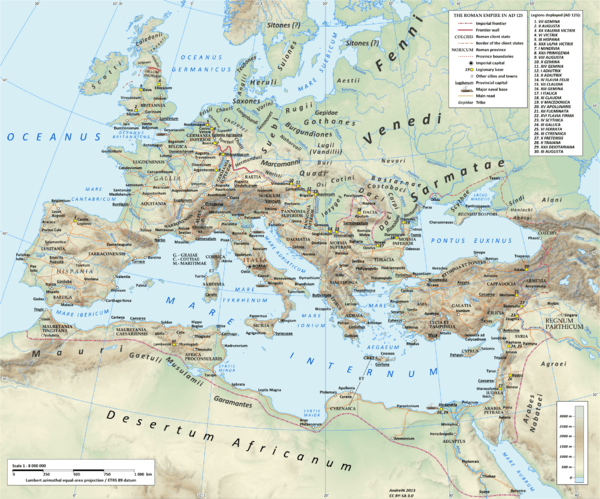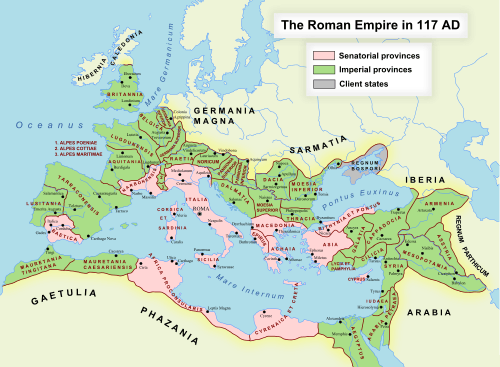Dalmatia (Roman province)
| Provincia Dalmatia | |||||
| Province of the Roman Empire | |||||
| |||||
 | |||||
| Capital | Salona | ||||
| Historical era | Antiquity | ||||
| - | Illyrian Wars | 220 BC - 168 BC | |||
| - | Established | 32 BC | |||
| - | Disestablished | 6th Century | |||
| Today part of | | ||||



Dalmatia was an ancient Roman province. Its name is probably derived from the name of an Illyrian tribe called the Dalmatae which lived in the area of the eastern Adriatic coast in Classical antiquity.
It encompassed much of today's Albania, Croatia, Bosnia and Herzegovina, Montenegro, Serbia etc, an area significantly larger than the current region of Dalmatia.
History
The region was the northern part[1] of the Illyrian kingdom between the 4th century BC until the Illyrian Wars in the 220s BC and 168 BC when the Roman Republic established its protectorate south of the river Neretva. The area north of the Neretva was slowly incorporated into Roman possessions until the province of Illyricum was formally established c. 32-27 BC.

The Dalmatia region then became part of the Roman province of Illyricum. Between 6 and 9 AD the Dalmatians raised the last in a series of revolts together with the Pannonians, but the rebellion was finally crushed, and in 10 AD Illyricum was split into two provinces, Pannonia and Dalmatia. The province of Dalmatia spread inland to cover all of the Dinaric Alps and most of the eastern Adriatic coast. Dalmatia was the birthplace of the Roman Emperor Diocletian, who, upon retirement from Emperor, built Diocletian's Palace near Salona in today's Croatia.[2]
German historian Theodore Mommsen wrote (in his The Provinces of the Roman Empire) that coastal Dalmatia and its islands were fully romanized and Latin speaking by the 4th century.[3] French archaeologist Bernard Bavant agrees with this.
Croatian historian Aleksandar Stipčević writes that analysis of archaeological material from that period has shown that the process of romanization was rather selective. While urban centers, both coastal and inland, were almost completely romanized, the situation in the countryside was completely different. Despite the Illyrians being subject to a strong process of acculturation, they continued to speak their native language, worship their own gods and traditions, and follow their own social-political tribal organization which was adapted to Roman administration and political structure only in some necessities.[4]
Aftermath
After the Western Roman Empire collapsed in 476, with the beginning of the Migration Period, the region was ruled by the Goths up to 535, when Justinian I added the territory to the Byzantine Empire. Later, the Byzantines formed the Theme of Dalmatia in the same territory.
Legacy
The first modern account of Roman Dalmatia in English was J.J. Wilkes, Dalmatia (Harvard University Press) 1969. Wilkes surveys Illyricum and Dalmatia, in its Romanized aspects, to the end of Antiquity, based primarily on the evidence of inscriptions and the ancient historians.
Episcopal sees
Episcopal sees of the Roman province of Dalmatia Inferior that are listed in the Annuario Pontificio as titular sees include:[5]
Episcopal sees of the Roman province of Dalmatia Superior that are listed in the Annuario Pontificio as titular sees include:[5]
Notes
- ↑ Thomas Kelly Cheyne and John Sutherland, BlackEncyclopaedia Biblica: A Critical Dictionary
- ↑ C.Michael Hogan, "Diocletian's Palace", The Megalithic Portal, Andy Burnham ed., Oct 6, 2007
- ↑ Theodor Mommsen; William Purdie Dickson; Francis Haverfield (1886). The Provinces of the Roman Empire: From Caesar to Diocletian. Gorgias Press LLC. pp. 203–. ISBN 978-1-59333-025-5.
- ↑ A. Stipčević, Iliri, Školska knjiga Zagreb, 1974, page 70
- ↑ 5.0 5.1 Annuario Pontificio 2013 (Libreria Editrice Vaticana 2013 ISBN 978-88-209-9070-1), "Sedi titolari", pp. 819-1013
External links
| ||||||||
